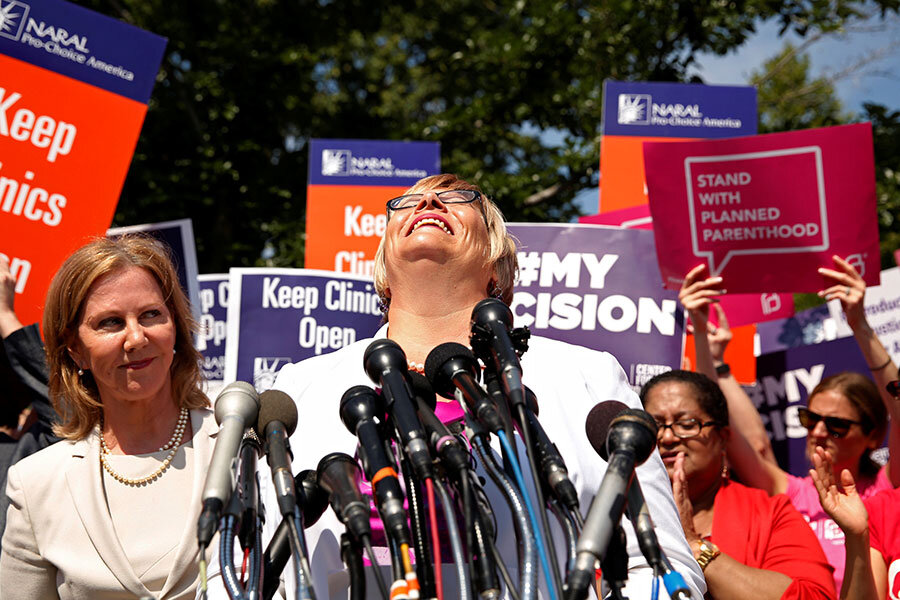How Supreme Court's abortion ruling could echo beyond Texas
The US Supreme Court issued its most important abortion decision in more than two decades Monday, striking down a Texas law regulating abortion clinics on the last day of its term.
The 5-to-3 opinion broke along ideological lines, with Justice Anthony Kennedy joining the liberal wing of the court in ruling that the law placed an undue burden on a woman’s constitutional right to get an abortion in the state.
The decision provides a vital clarification on how states can regulate abortion clinics, rejecting Texas’s claims that the law is needed to protect women’s health – an increasingly common approach to antiabortion laws.
Dozens of states have adopted similar laws, and abortion clinics have been closing at a record pace around the country.
Monday’s decision represents a sharp reversal of fortunes, suggesting that abortion rights advocates could now begin challenging other laws around the country.
"This decision only addressed two of the many, many restrictions women face to get abortion care in Texas," said Amy Hagstrom Miller – founder and CEO of Whole Woman’s Health, the lead plaintiff in the case. "Now we must redouble our efforts across the country to end similar state restrictions that push abortion out of reach for too many women."
The case concerns Texas House Bill 2, a 2013 law requiring that abortion providers meet two new requirements: that they have admitting privileges at a local hospital, and that their facilities comply with the standards of an ambulatory surgical center.
But the court asserted that the law provides “few, if any” health benefits and places a “substantial obstacle” to women seeking an abortion, violating their constitutional rights.
“Neither of these provisions offers medical benefits sufficient to justify the burdens upon access that each imposes,” wrote Justice Stephen Breyer for the majority.
In a concurring opinion, Justice Ruth Bader Ginsburg added: “Many medical procedures, including childbirth, are far more dangerous to patients, yet are not subject to ambulatory-surgical-center or hospital admitting-privileges requirements.
“Given those realities, it is beyond rational belief that HB2 could genuinely protect the health of women, and certain that the law would simply make it more difficult for them to obtain abortions,” she added.
Justice Breyer’s opinion specifically cited research showing that since HB2 became law, the number of abortion clinics in Texas fell from 40 to 19, while the number of women living more than 200 miles from a clinic rose from 10,000 to 290,000.
The new requirements led to the closures, Breyer wrote, and the closures “meant fewer doctors, longer waiting times, and increased crowding.” Taken together, he said, in addition to the increased driving distances imposed on many women, “lead us to conclude that the record adequately supports the … ‘undue burden’ conclusion.”
The court’s decision this morning represents a landmark clarification of how states can regulate abortion.
In 1992, the court ruled in Planned Parenthood of Southeastern Pennsylvania v. Casey that regulations are permissible so long as they don’t impose an “undue burden”— a “substantial obstacle in the path of a woman seeking an abortion before the fetus attains viability.” Monday, it clarified what constitutes and “undue burden.”
The court’s dissenting justices – Samuel Alito, Clarence Thomas, and Chief Justice John Roberts – argued that the case should not have been heard at all.
Abortion-rights groups challenged HB 2 when the law initially went into effect, but the US Fifth Circuit Court of Appeals dismissed the case, and the petitioners chose to not argue their case to the Supreme Court.
To the dissenting justices, this case felt like an attempt to retry the former case.
“Petitioners had a fair opportunity to make their case, but they lost,” Justice Alito wrote in a dissent.
The majority countered by arguing that new information about the law’s impact on clinics justified a new lawsuit.
“Factual developments may show that constitutional harm, which seemed too remote or speculative to afford relief at the time of an earlier suit, was in fact indisputable,” Breyer wrote.
In her concurring opinion, Justice Ginsburg suggested that the decision could threaten similar laws around the country.
“So long as this Court adheres to Roe v. Wade, and Planned Parenthood of Southeastern Pa. v. Casey,” she wrote, laws like HB 2 “cannot survive judicial inspection.”
Between 2011 and 2015, states adopted 288 new abortion regulations, with around two-dozen enacting laws or policies similar to the Texas law, according to the Guttmacher Institute, a nonprofit group that tracks reproductive health issues.
Such laws are in effect in Mississippi, Wisconsin, Alabama, Oklahoma and Michigan.
To antiabortion activists, the ruling was a setback.
“The abortion industry cannot be trusted to regulate itself and they know it,” said Marjorie Dannenfelser, president of the Susan B. Anthony List, in a statement.
For abortion rights activists, it is a starting point toward reversing the shrinking numbers of clinics
“This win doesn’t mean the struggle for abortion access is over,” said Ms. Hagstrom Miller of Whole Woman’s Health in call with reporters. “Clinics don’t reopen overnight.”
Staff writer Warren Richey contributed to this report.







